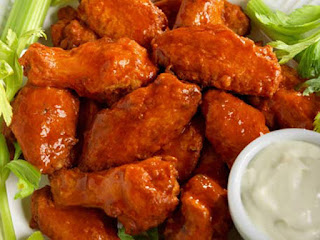The Super Bowl, which is scheduled for 6:30 p.m. on Sunday, is one of the most watched events in the U.S., with an estimated 100 million television viewers. The Super Bowl also is a prime time for foodborne illnesses, with viewers expected to eat approximately 1.3 billion chicken wings, says the U.S. Department of Agriculture. Each year 48 million Americans get sick from foodborne illnesses, largely because of unsafe food handling practices.
USDA offers some tips for your Super Bowl party, including keeping foods out of the "danger zone," which is the temperature range between 40 degrees Fahrenheit and 140 degrees. In the danger zone "bacteria can multiply rapidly, causing a single bacterium to multiply to 17 million in 12 hours. Avoid serving Super Bowl favorites, such as pizza and chicken wings, at room temperature for the entire game."
When serving food or ordering takeout food, USDA suggests:
USDA offers some tips for your Super Bowl party, including keeping foods out of the "danger zone," which is the temperature range between 40 degrees Fahrenheit and 140 degrees. In the danger zone "bacteria can multiply rapidly, causing a single bacterium to multiply to 17 million in 12 hours. Avoid serving Super Bowl favorites, such as pizza and chicken wings, at room temperature for the entire game."
When serving food or ordering takeout food, USDA suggests:
- If warm takeout foods are to be served immediately, keep them at 140 degrees or above by placing in chafing dishes, preheated warming trays or slow cookers.
- If take-out foods will not be served immediately, either keep them warm in a preheated oven, or divide the food into smaller portions or pieces, place in shallow containers, and refrigerate. At serving time, reheat to 165 degrees.
- Cold foods that are served should be kept at 40 degrees or below, which can be done by nesting serving dishes in bowls of ice. Avoid storing food outside, where the sun can quickly warm foods in plastic storage containers and animals can get into.
- Start a game-day tradition by using a food thermometer to ensure foods being served to guests are not in the "Danger Zone."
- Do not wash raw chicken wings. Sixty-seven percent of respondents in a 2016 FDA food safety survey indicated they washed raw chicken parts; however, washing will not destroy pathogens and may increase the risk of contaminating other foods and surfaces.
- Ensure chicken wings are safe to eat by verifying they have reached an internal temperature of 165 degrees. Take the temperature of multiple wings in the thickest part of the wing, being careful to avoid the bone.

No comments:
Post a Comment